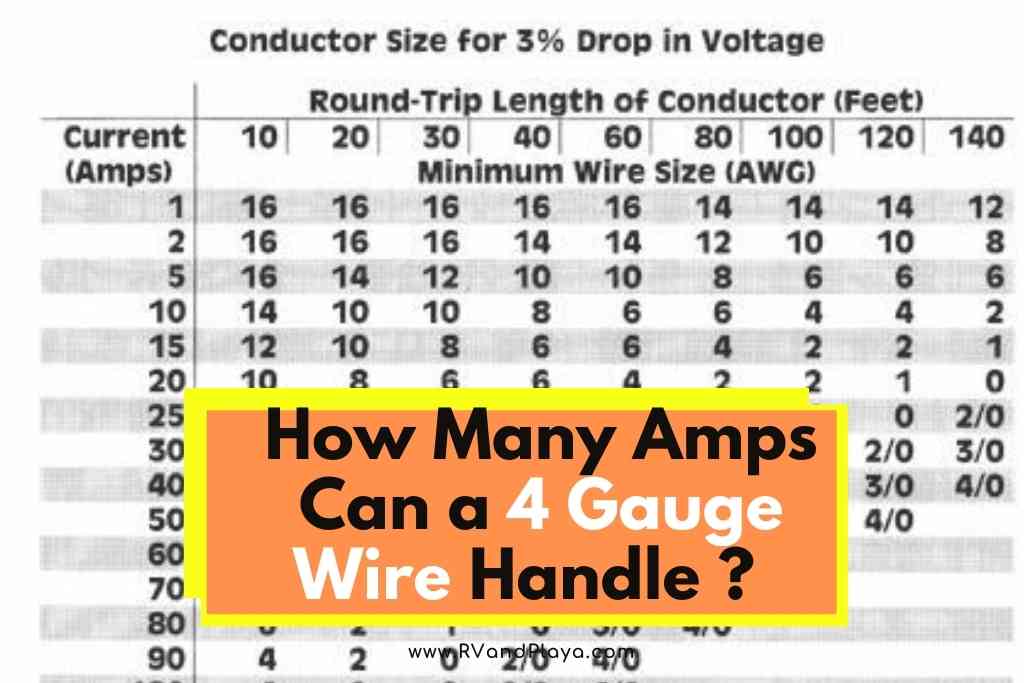Have you ever asked yourself or your friend how many Amps a 4 gauge wire can handle? Well, you are at the perfect place to find the answer to such a question.
You don’t have to be an electrician to have a basic understanding of wiring, including the amperage, voltage, and wattage of various appliances and the wires they use to plug in, along with the wiring in your house.
Its important information and will serve you well if you’re faced with a potential DIY repair.
So, how many Amps can a 4 gauge wire handle? A 4 gauge wire is capable of handling up to 70 amps but that’s not where the story ends. There are temperature ratings to consider as well as aluminum versus copper wiring.
So, 70 amps aren’t all a 4-gauge wire is capable of handling, depending on temperature ratings, type of wire, or whether the wiring is copper or aluminum.
The National Electric Code (NEC) has a chart that shows you the allowable amperages for each temperature-rated gauge in both copper and aluminum.
Table of Contents
What’s the Difference Between 4-Gauge Copper and 4-Gauge Aluminum?
Aluminum is a metal that is resistant to both current and heat. As such, the same gauge of aluminum wiring—4-gauge in this case—won’t conduct the same number of amps that an equivalent copper wire will.
For instance, at a temperature rating of 167°F, a 4-gauge copper wire is capable of conducting 85 amps while the equivalent aluminum wire at a temperature rating of 167° is only capable of conducting 65 amps.
There are different temperature ratings for each type of wire.
| Temp Rating | 140° | 167° | 194° |
| 4-gauge Copper | 70 | 85 | 95 |
| 4-gauge Aluminum | N/A | 65 | 75 |
There are also many different insulation types, and while they don’t affect the kind of current that the copper or aluminum can conduct, they are necessary for the temperature rating or for what the application for the copper or aluminum wiring is going to be.
Read also: How Many Amps Can a 14 Gauge Wire Handle? (Best Tips)
Although aluminum is regarded as one of the top five metals in terms of electrical usage, you can tell the separation between it and other conductive metals and that gap is a fairly wide one.
Aluminum doesn’t have a usage at a 140° temperature rating and is 20 amps below its copper cousin at both the 167° temperature rating and the 194° temperature rating.
If 4-gauge copper wiring was considered an uncommon wire, aluminum is even more so, by a long shot.
The temperature rating differences determine the type of insulation that the wire will be jacketed in.
- At 140°F – NM-B, UF-B
- At 167°F – THW, THWN, SE, USE, XHHW
- At 194°F – THWN-2, THHN, XHHW-2, USE-2
- Aluminum at 167°F – THW, THWN, SE, USE, XHHW
- Aluminum at 194°F – XHHW-2, THHN, THWN-2
In other words, there are different insulation jackets for 4-gauge and all of them are based on determined temperature ratings which, in turn, are determined by the application of the wire.
What is 4-Gauge Wire Typically Used For?
You don’t see 4-gauge wiring in a lot of applications and you certainly won’t see it in any kind of residential or most commercial wiring.
Manufacturing industries use it more for large-scale projects that dwarf anything that you would see in a neighborhood.
As far as a home is concerned, there won’t be any 4-gauge wiring in the electrical system unless something wild and crazy was added before you purchased the home. There’s just no application for it.
Even the most power-hungry appliances such as washers, dryers, your HVAC system, and water heaters won’t use anything more than a 10-gauge wire.
Your washing machine uses a 12-gauge and it all makes you wonder what in the world you would need a 4-gauge wire for?
In fact, you could use it in most of your residential appliances if you wanted to waste some money. After all, 4-gauge is more than capable of handling 10, 15, and 20 amps with little to no effort at all.
For practical purposes, however, you will only find 4-gauge wiring in industrial-sized furnaces and large electric heaters; the kind you would find at an industrial level.
Unless you live in a mansion, there’s nothing in your home that’s going to require that kind of wire thickness to operate.
Read also: How Many Amps Can a 10 Gauge Wire Handle (220 Volts)
The truth is, 4-gauge wire isn’t listed in most industrial or residential manuals as a common wire, simply because it is not.
While there are applications for 4-gauge wire, there’s nothing there that 6-gauge can’t normally handle or 2-gauge for something larger scale.
The lack of applications has ultimately relegated 4-gauge wire to a kind of background, novelty wire gauge. You can find it in battery cables sometimes, but nowhere near as much as 2 and 6 gauge.
What is the Voltage Drop with 4-Gauge Copper and Aluminum Wire?
Voltage drop is defined as the amount of current loss over specific distances. The more feet that you string a wire out, the more voltage it loses from the starting point to the ending point.
This is true of all wiring and there’s a percentage of loss despite the placement of or lack of resistance mechanisms.
If you ever want to know the voltage drop for a given gauge, inside of a bubble—as in a rating without any external or internal factors that could change the math—you can always jump online and use a voltage-drop calculator.
For instance, if you were to string out 500’ of 4-gauge wire and you wanted to know the drop in voltage at the other end of where you’re plugged in, it would be about a 17.4V loss at a rate of 14.5%.
Of course, if you’re running something as big as 4-gauge, a 17V loss is probably going to be negligible at best. And honestly, 500’ is a pretty long distance to stretch 4-gauge wire, for whatever reason that you would want to.
There are 4 main factors that affect voltage drops in wiring, and it’s true whether you are using aluminum or copper.
- Distance of the wire as it is laid out
- Gauge of the wire
- Amount of current that is being used
- Silver, copper, gold, or aluminum as a conduit
If you thought that 4-gauge wire was rare, try finding four gauge wire that is made out of gold or silver, two metals that are far superior to copper and especially aluminum, in terms of how well it conducts electricity.
You can determine what the voltage drop is going to be if you memorize or have a chart covering the ohm resistance of a specific gauge wire over 1,000’ of distance.
The formula for determining voltage drop is Vdrop = I * R.
“I” stands for the number of amps while “R” stands for the level of resistance for that particular wire. For example, let’s use the 70A current again and say that there is 1,000’ of 4-gauge wire.
The ohm resistance for that distance and gauge is 0.2485.
So that would be 0.2485 * 70 = Vdrop. The result would be a voltage drop of 17.4V. It’s a pretty simple formula for determining the voltage drop in several hundred feet of 4-gauge wire.
Final Thoughts
So, your standard amperage that’s going to be applied to 4-gauge wire is 70, and nada when it comes to aluminum unless you step up the temperature ratings.
Although you won’t find many applications for the use of 4-gauge wire, regardless of its makeup, there are some uses for it and now you know what it can handle.
Here are some of my favorite tools & equipment´s
Thank you for reading this article. I hope it helps you find the most recent and accurate technical and repair information for your car. Here are some tools that I use as an automotive technician and hope you´ll also find helpful.
There are affiliate links, so if you do decide to use any of them, I´ll earn a small commission. But in all honesty, these are the exact tools that I use and recommend to everyone, even my own family. (NO CRAP)
To see all my of most up-to-date recommendations, check out this resource that I made for you!
References
https://www.knukonceptz.com/assets/pdf/PowerWireSpec.pdf
https://www.seniorcare2share.com/how-big-is-4-gauge-wire/
Recent Posts
When it comes to the gauge (thickness) of copper wire—or aluminum—the allowable current flow is debatable between what is safe and falls within code, and what it can carry. For safety...
When it comes to wire sizes and the supposed amperage, they can tolerate there is a general rule of thumb that is applied across the board for various wire sizes. However, it’s not always as cut...


